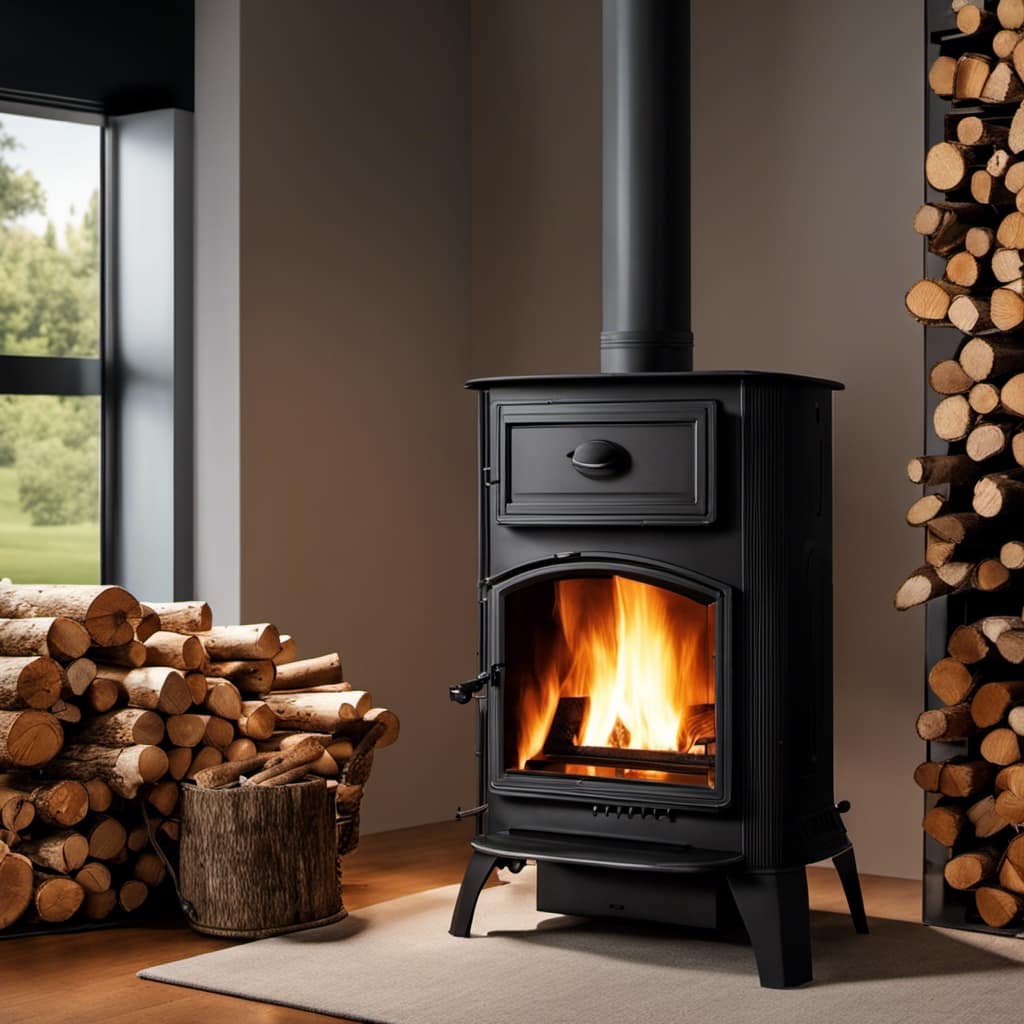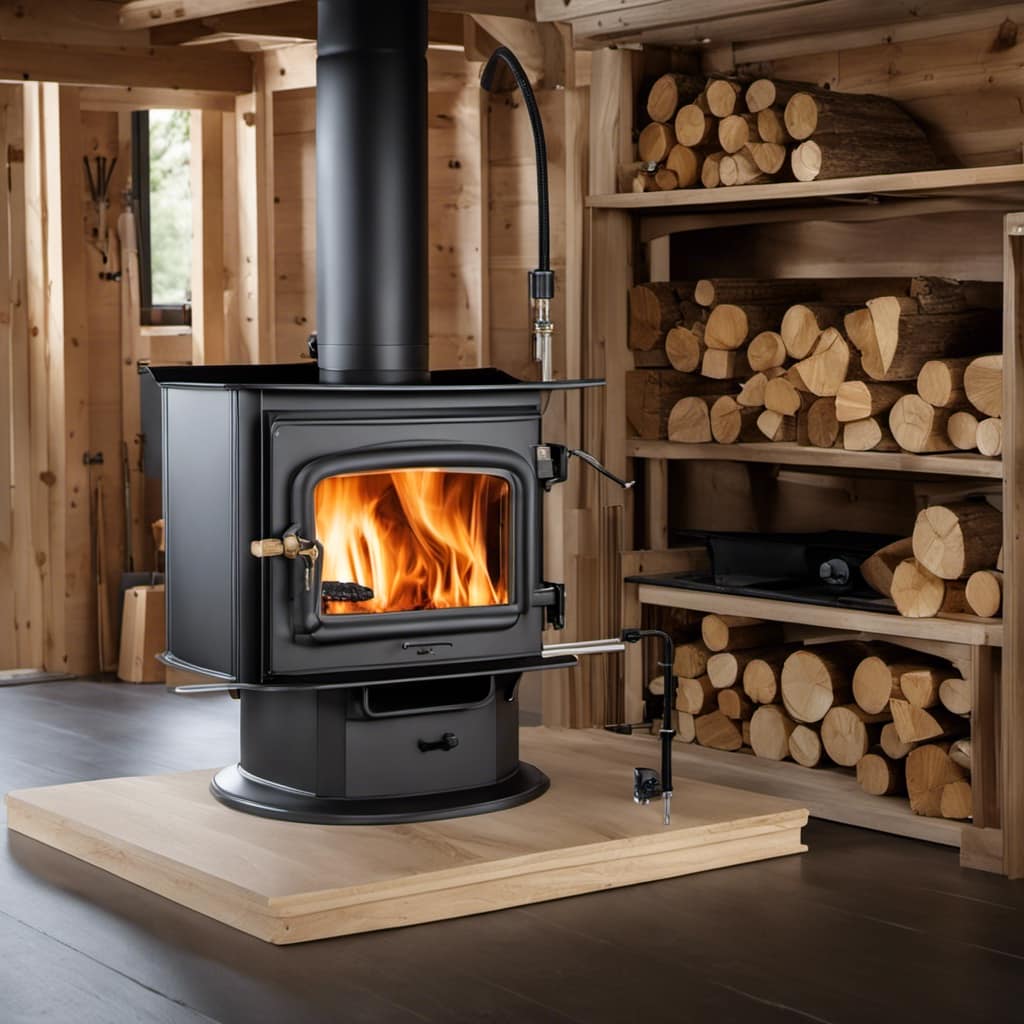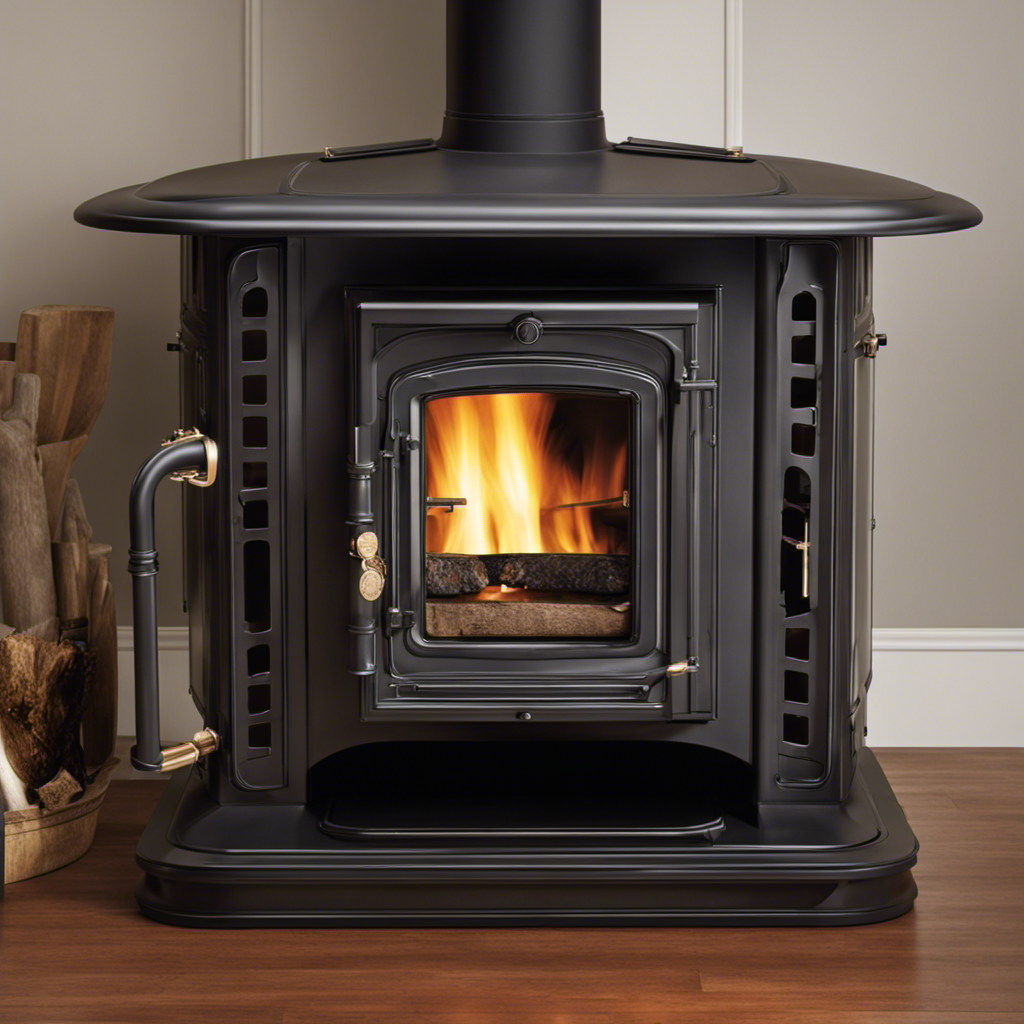
I understand your curiosity: why does my wood stove produce so much ash? Don’t worry, I have the answers you seek. In this article, we will explore the combustion process in wood stoves and discover the reasons behind ash accumulation.
But it doesn’t stop there. I’ll also share some techniques for managing ash and shed light on the environmental impact of this common byproduct.
Get ready to become an ash expert!
Key Takeaways
- The combustion process in wood stoves involves the interaction of oxygen, fuel, and heat.
- Ash forms as a byproduct of the combustion process in wood stoves and typically contains minerals like calcium, potassium, and magnesium.
- Factors such as the type of wood burned and the temperature at which it is burned influence ash production.
- Regular cleaning and proper ash disposal are essential for maintaining a clean and efficient wood stove environment.
The Combustion Process in Wood Stoves
I love watching the flames dance inside my wood stove during the combustion process. It’s fascinating to see how the fire transforms the wood into heat and energy.

The combustion process in wood stoves is a complex one, involving the interaction of oxygen, fuel, and heat. As the fire burns, the wood releases gases that ignite and produce flames. These flames generate heat, which is then distributed throughout the room.
Heat distribution is an essential aspect of a wood stove’s efficiency. To improve efficiency, it’s crucial to ensure proper airflow and combustion. This can be achieved by using dry, well-seasoned wood and adjusting the air vents to achieve the optimal burn.
Understanding the Formation of Ash in Wood Stoves
Ash forms in wood stoves due to the combustion process, where wood releases gases that ignite and produce flames. As the wood burns, it undergoes a transformation, leaving behind ash as a byproduct.
The composition of ash varies depending on the type of wood burned, but it typically contains minerals such as calcium, potassium, and magnesium. These minerals can be beneficial for plants when used as a fertilizer.

However, disposing of ash requires careful consideration. One option is to spread it in the garden as a soil amendment, but this should be done in moderation to avoid altering the pH levels.
Alternatively, ash can be bagged and disposed of in the trash, as long as it’s completely cooled to prevent any fire hazards.
Proper ash disposal is essential for maintaining a safe and clean wood stove environment.
Factors Influencing Ash Production in Wood Stoves
The amount of ash produced in wood stoves can be influenced by factors such as the type of wood being burned and the temperature at which it’s burned.

Different types of wood have varying levels of density and moisture content, which can impact the amount of ash generated. Hardwoods, like oak or maple, tend to produce less ash compared to softwoods, such as pine or fir.
Additionally, the temperature at which the wood is burned plays a crucial role in ash production. Burning wood at higher temperatures promotes more complete combustion, resulting in fewer ash particles. On the other hand, lower temperatures can lead to incomplete combustion and increased ash accumulation.
Understanding these factors affecting ash production can help in minimizing ash accumulation and maximizing the efficiency of wood stoves.
Ash Management Techniques for Wood Stove Users
Interestingly, using proper ash management techniques can significantly reduce the amount of residue left behind from wood stove usage. Proper ash disposal is crucial for maintaining a clean and efficient wood stove. Here are three effective ways to minimize ash buildup:

-
Regular cleaning: Cleaning your wood stove regularly is essential to prevent ash buildup. Use a metal scoop or shovel to remove the ashes and dispose of them in a metal container. Make sure the ashes are completely cool before disposing of them.
-
Ash removal system: Some wood stoves come with built-in ash removal systems, making it easier to dispose of the ashes. These systems allow you to remove the ashes without having to open the stove door, minimizing the risk of spreading ash around the room.
-
Ash vacuum: Using an ash vacuum is another convenient way to remove ashes from your wood stove. These specially designed vacuums are equipped with filters that trap fine particles, preventing them from being released back into the air.
The Environmental Impact of Ash From Wood Stoves
I’ve noticed that the ash produced by my wood stove can have a significant environmental impact. It got me thinking about the recycling potential of wood stove ash and the impact it has on air quality.

Wood stove ash is actually quite versatile and can be recycled in a number of ways. One option is to use it as a soil amendment in gardens and agricultural fields. The ash contains nutrients like potassium and calcium that can benefit plant growth.
Another option is to use it as a component in concrete or as a filler in road construction. However, it’s important to note that the ash should undergo proper testing to ensure it doesn’t contain harmful substances like heavy metals.
As for air quality, wood stove ash can contribute to air pollution if not properly managed. Fine particles in the ash can become airborne and be inhaled, leading to respiratory issues. It’s crucial to dispose of ash in a responsible manner, such as sealing it in a bag and placing it in the trash or using it for recycling purposes.
Frequently Asked Questions
How Long Does It Take for Ash to Accumulate in a Wood Stove?
It takes approximately 1-2 weeks for ash to accumulate in a wood stove, depending on usage. Regular wood stove maintenance, such as cleaning the ash regularly and using proper ash disposal methods, is essential to prevent buildup and maintain efficiency.

Can the Type of Wood Used Affect the Amount of Ash Produced?
The type of wood used in a wood stove can affect the amount of ash produced. Hardwood tends to produce less ash than softwood due to its lower moisture content.
What Are the Different Types of Ash That Can Be Produced in a Wood Stove?
There are various types of ash that can be produced in a wood stove, each with different uses. However, it’s important to note that excessive ash accumulation can negatively impact the stove’s efficiency.
Is It Normal for a Wood Stove to Produce More Ash During Certain Seasons?
During certain seasons, it is normal for a wood stove to produce more ash. This can be influenced by factors such as the type of wood being burned, the temperature at which the stove is operated, and the frequency of use.
Are There Any Health Risks Associated With Ash From Wood Stoves?
There are health risks associated with ash from wood stoves. It contains fine particles that can irritate the respiratory system. Proper disposal methods, such as sealing it in a bag before throwing it away, can help minimize exposure.

Conclusion
In conclusion, the formation of ash in wood stoves is a natural byproduct of the combustion process. Factors such as the type of wood, temperature, and airflow influence the amount of ash produced.
By properly managing and disposing of ash, wood stove users can minimize its environmental impact.
So remember, just like a phoenix rising from the ashes, your wood stove creates ash as a testament to its efficient and powerful heat-generating capabilities.
Growing up surrounded by the vast beauty of nature, Sierra was always drawn to the call of the wild. While others sought the comfort of the familiar, she ventured out, embracing the unpredictable and finding stories in the heartbeat of nature.
At the epicenter of every remarkable venture lies a dynamic team—a fusion of diverse talents, visions, and passions. The essence of Best Small Wood Stoves is crafted and refined by such a trio: Sierra, Logan, and Terra. Their collective expertise has transformed the platform into a leading authority on small wood stoves, radiating warmth and knowledge in equal measure.











